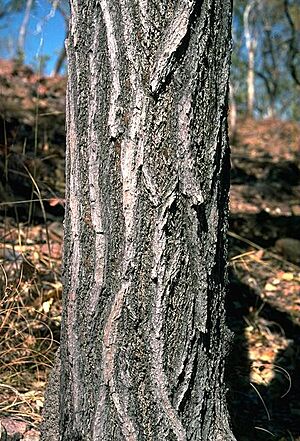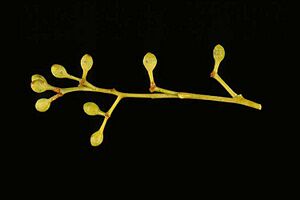Wandi ironbark facts for kids
Quick facts for kids Wandi ironbark |
|
|---|---|
 |
|
| Eucalyptus jensenii at the Gibb River Station | |
| Scientific classification | |
| Genus: |
Eucalyptus
|
| Species: |
jensenii
|
| Synonyms | |
|
|
The Wandi ironbark (Eucalyptus jensenii) is a special tree found only in northern Australia. It's known for its tough, dark "ironbark" on the trunk. This tree has leaves shaped like eggs or spears, and its flowers are creamy white. Its fruit looks like small barrels or cones.
Contents
About the Wandi Ironbark Tree
The Wandi ironbark is a tree that usually grows to be about 3 to 12 meters tall. That's like a building with one to four floors! It has a special part called a lignotuber, which helps it regrow after fires.
Bark and Leaves
The trunk and big branches of the Wandi ironbark have very hard, rough, and dark "ironbark." This bark feels coarse, like a rough cloth.
Young Wandi ironbark plants have dull, grayish-green leaves. These leaves are shaped like eggs or ovals. They are about 38 to 65 millimeters long and 20 to 30 millimeters wide.
As the tree grows, its adult leaves are also dull green or grayish-green. They are shaped like eggs or spears. These adult leaves are longer, about 43 to 115 millimeters long and 7 to 30 millimeters wide. Each leaf sits on a small stem called a petiole, which is 3 to 20 millimeters long.
Flowers and Fruit
The Wandi ironbark's flower buds grow mostly at the ends of its branches. They are arranged in groups of seven. Each group of seven buds is on a small stalk called a peduncle, which is 2 to 8 millimeters long. Each individual bud also has its own tiny stalk, called a pedicel, which is 2 to 8 millimeters long.
When the buds are ready to open, they look like small pears or ovals. They are about 3 to 4 millimeters long and 2 to 3 millimeters wide. Each bud has a cone-shaped cap called an operculum.
The Wandi ironbark blooms from January to May. Its flowers are a lovely creamy white color. After the flowers, the tree produces woody fruit. These fruits are shaped like small barrels or cones. They are about 3 to 5 millimeters long and wide. Inside, they have valves that are almost level with the rim.
How the Wandi Ironbark Got Its Name
The Wandi ironbark was first officially described in 1922. A scientist named Joseph Maiden wrote about it. He used a plant sample collected near a place called Wandi. This sample was found by Harald Ingemann Jensen, a geologist.
The name jensenii was chosen to honor Harald Ingemann Jensen, the person who collected the first sample of this tree. Wandi is an old gold-mining area near Pine Creek in the Northern Territory.
Where Wandi Ironbark Lives
The Wandi ironbark grows in open forests and woodlands. You can often find it on slopes and flat areas called tablelands. Sometimes, it even grows near swamps.
This tree is found in the Kimberley region and Dampier Peninsula in Western Australia. It also grows in the northern parts of the Northern Territory, including on Groote Eylandt.



